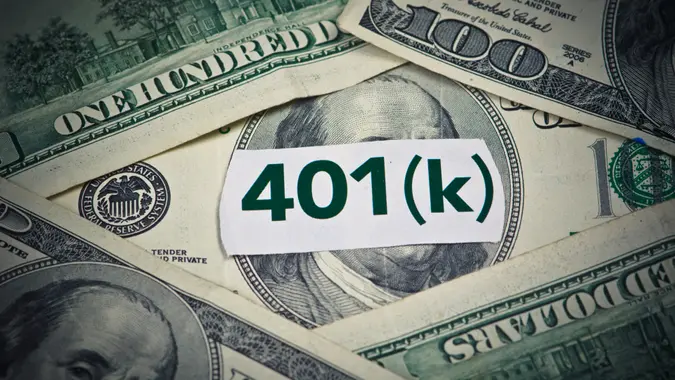How to Avoid Taxes on a 457 Withdrawal

Commitment to Our Readers
GOBankingRates' editorial team is committed to bringing you unbiased reviews and information. We use data-driven methodologies to evaluate financial products and services - our reviews and ratings are not influenced by advertisers. You can read more about our editorial guidelines and our products and services review methodology.

20 Years
Helping You Live Richer

Reviewed
by Experts

Trusted by
Millions of Readers
With a 457(b) plan, the biggest advantage is flexibility — you can withdraw money penalty-free once you leave your employer, no matter your age. But that doesn’t mean withdrawals are automatically tax-free. Unless you plan carefully, you could owe a significant chunk of your savings to the IRS.
This guide breaks down the smartest ways to take money from your 457 account while minimizing, or even avoiding, taxes.
What Is a 457 Plan and How Does It Work?
A 457(b) plan is a tax-advantaged retirement account typically offered to state and local government employees, as well as certain nonprofit workers. Participants can contribute a portion of their salary on a pre-tax basis, allowing their savings to grow tax-deferred until withdrawal.
Key Features of a 457(b) Plan
- Eligibility: Available to state and local government employees, as well as certain nonprofit workers.
- Tax Treatment: Contributions are made with pre-tax dollars, and earnings grow tax-deferred.
- Contribution Limits: Up to $23,000 in 2025. If you’re 50 or older, you can make an additional $7,000 in catch-up contributions.
- Withdrawals: No early withdrawal penalty–you can access funds once you separate from your employer, regardless of age.
- Required Minimum Distributions (RMDs): Must begin at age 73.
- Rollover Options: Funds can be rolled over into a 401(k), IRA, or another 457(b) plan.
Are 457 Withdrawals Taxable?
Yes. Money you take out of a 457(b) plan is taxed as ordinary income, just like a paycheck. The key advantage is that, unlike a 401(k) or 403(b), there’s no 10% early withdrawal penalty if you access your funds before age 59½ — as long as you’ve separated from your employer.
That said, “penalty-free” doesn’t mean “tax-free.” Withdrawals are still subject to federal income tax and, in most cases, state income tax, depending on where you live. The amount you owe will depend on your overall tax bracket and other sources of income for the year.
Tax Treatment for 457 Withdrawals
How your 457 plan withdrawals are taxed depends on the type of account and how you take the money out. Here’s a quick breakdown:
| Withdrawal Type | Pay Taxes? | Details |
|---|---|---|
| Pre-tax 457(b) withdrawal | Yes | Taxed as ordinary income, but no early withdrawal penalty |
| Rollover to IRA/401(k) | Yes | Taxes apply when you withdraw funds from the IRA or 401(k) |
| Roth 457 (rare offering) | No | Withdrawals are tax-free if the account is at least 5 years old and you’re age 59½ or older |
A traditional 457(b) offers flexibility since withdrawals avoid early penalty fees, while a Roth 457 — though less common — can provide tax-free income in retirement if you meet the requirements.
Penalty-Free Doesn’t Mean Tax-Free
You won’t pay a penalty for early withdrawals from your 457 plan, but taxes still apply.
When Do You Pay Taxes on 457 Withdrawals?
You’ll owe taxes in the year you take the withdrawal. Distributions from a 457(b) plan are taxed as ordinary income, meaning they’re added to your other taxable income for that year. While many retirees find themselves in a lower tax bracket once they stop working, that’s not always the case–especially if you have multiple income sources. That’s why it’s wise to work with a financial advisor to time withdrawals in a way that minimizes your tax bill.
In addition, once you turn 73, you’ll be required to start taking required minimum distributions (RMDs) from your 457(b), even if you don’t need the money. Missing an RMD can lead to steep IRS penalties, so it’s important to plan ahead.
Here’s an example: Suppose you retire at 62 and don’t immediately tap into your 457(b). During those years, your taxable income may be relatively low, so smaller withdrawals could be taxed at a favorable rate. But by 73, you’ll have to begin taking RMDs whether you need the funds or not — potentially pushing you into a higher tax bracket if you delay withdrawals for too long.
Strategies to Avoid or Reduce Taxes on 457 Withdrawals
Taxes are inevitable, but there are ways to lower your tax burden. Here are some strategies:
- Withdraw in low-income years. If you don’t need to take a withdrawal, try to wait until you hit a lower tax bracket.
- Roll over to your IRA or 401(k). You can delay taxes by rolling over to these retirement accounts.
- Consider a Roth IRA. Convert your 457 plan to a Roth IRA during low-income years.
- Split your withdrawal. You can take withdrawals by staggering these payouts over several years.
- Be savvy with the funds. You can use the funds for qualified expenses like medical costs. Taxes for qualified expenses may be deductible.
- Relocate. Some states don’t tax retirement income.
- Use the standard deduction on your returns. Take only as much as what keeps your taxable income low.
How a 457(b) Compares to a 401(k) and 403(b)
Understanding how a 457(b) stacks up against other common retirement plans — like a 401(k) or 403(b) — can help you make smarter decisions about where to save.
While all three plans offer tax-deferred growth and require minimum distributions starting at age 73, there are some important differences to note.
| Feature | 457(b) | 401(k) | 403(b) |
|---|---|---|---|
| Early Withdrawal Penalty | No penalty if you separate from your employer (government plans only) | 10% penalty before age 59½ | 10% penalty before age 59½ |
| Taxation at Withdrawal | Yes; taxed as ordinary income | Yes; taxed as ordinary income | Yes; taxed as ordinary income |
| Rollover Options | Allowed (to 401(k), IRA, or another 457) | Allowed | Allowed |
| Required Minimum Distributions (RMDs) | Yes, starting at age 73 | Yes, starting at age 73 | Yes, starting at age 73 |
The biggest difference is the penalty-free early access feature of the 457(b), which makes it more flexible if you plan to retire or change jobs before age 59½.
You Can’t Skip Taxes, But You Can Lower Them
The standout advantage of a 457(b) plan is flexibility — you won’t face a penalty for taking money out early once you’ve left your employer. That said, “penalty-free” doesn’t mean “tax-free.” All withdrawals are still subject to ordinary income tax.
The key is to be strategic: consider rolling funds into another retirement account, like a Roth IRA, or timing withdrawals during years when your income–and therefore your tax bracket–is lower. Smart planning can help you keep more of your savings working for you.
FAQ
- Are 457 plan withdrawals taxed as ordinary income?
- Yes. Any money you withdraw from a 457(b) plan is added to your taxable income for the year and taxed at your regular income tax rate.
- Can I avoid taxes by rolling over my 457 plan?
- You can defer them. Rolling funds into an IRA, Roth IRA, or another eligible retirement plan lets you postpone paying taxes. But keep in mind: withdrawals from the new account will eventually be taxed (unless it’s a Roth IRA and you meet the requirements).
- Is there a penalty for withdrawing from a 457 plan early?
- No. Unlike a 401(k) or 403(b), a 457(b) plan doesn’t impose a 10% early withdrawal penalty once you separate from your employer. However, you’ll still owe income taxes on what you take out.
- What’s the best way to minimize taxes on a 457?
- Plan your withdrawals strategically. Many retirees wait until they’re in a lower tax bracket to take distributions, or spread withdrawals over multiple years to avoid pushing themselves into a higher bracket. Coordinating withdrawals with other income sources can also reduce your overall tax bill.
- Do you have to take RMDs with a 457?
- Yes. Starting at age 73, you’re required to begin taking required minimum distributions (RMDs) from your 457(b), even if you don’t need the money.
 Written by
Written by  Edited by
Edited by 

























